Meet your elephant and learn their story
Fahlo | The Expedition Elephant | Plush
* Fahlo® donates 10% of profits to our nonprofit partners
* Stuffing made from recycled water bottles
* Huggable for all ages
* Size: 12"
Every Fahlo® tracking experience includes the Fahlo Protection Ping™. This indicates each animal’s unique path may be live, delayed, or historical based on required safety protocol in accordance with our nonprofit partners.
While the experience of following an animal’s journey remains the same for you, we work behind the scenes with our partners to ensure it is presented in a way that keeps the animals safe, one step or splash at a time.

Each plush comes with a real elephant to track

Reveal exclusive stats, photos, and updates along the way
Follow their journey on a 3D tracking map

In partnership with Save the Elephants

Common questions
Why are elephants tracked?
Save the Elephants (STE) uses GPS-tracking equipment to better understand elephant movements and behaviour. As the human population grows across Africa and the landscape gets increasingly crowded, this tracking data is key to defining and protecting elephant habitats and the corridors that link areas used by both elephants and other wildlife. To date, STE has tracked over 900 elephants!
Using this technology they can also tell when an elephant has become unnaturally mobile – a warning that can indicate that an elephant is in trouble. These alerts are issued to wildlife management teams to allow a rapid response and can make the difference between life and death.
STE provides Fahlo with delayed tracking data for security reasons so we’re never giving away an elephant’s live location. Despite this delay, you’ll still receive a near daily update of your elephant’s location from just a few weeks ago!
To learn more about why elephants are tracked, visit our partner Save the Elephants directly at savetheelephants.org.
How does tracking work?
“Elephant collars contain a small transmitter and use GPS and satellite tracking technology (similar to what we use in car navigation systems). Save the Elephants monitors the location of a collared elephant at regular intervals (every 30–60 minutes). This information plays an important part in defining and protecting elephant corridors. We later plot these coordinates on a map so you can see where your Fahlo elephant has traveled!” - Save the Elephants
To learn more, visit our partner directly at savetheelephants.org.
Does tracking harm the elephants?
“No—the collar does not harm the elephant; it is very light and sits loosely around the neck like a pendant would on us. Collaring is carefully performed by an experienced team. Firstly, an elephant is located by a ground team or from the air, then a vet will prepare and shoot a dart containing an anesthetic. A collar is fitted as quickly and safely as possible before the vet helps revive the elephant in minutes.” - Save the Elephants
To learn more, visit our partner directly at savetheelephants.org.
How smart is an elephant?
With the largest brain of any land animal, elephants are incredibly smart. They can use tools, understand human body language and mimic human voices, show empathy toward other animals and each other, and demonstrate astounding capabilities to create and store memories. It’s the reason you may have heard that elephants never forget!
Why are elephants going extinct?
The greatest factors contributing to elephant extinction are all related to human activity; the sharing of land in Asia and Africa has created conflict between humans and elephants, making them targets. The most harmful activities include poaching, hunting them for their ivory, and habitat destruction.
What are elephants scared of?
Surprisingly, elephants are most scared of two very small creatures: bees and mice. Bees scare them because they tend to swarm. While one bee sting is relatively harmless, hundreds of stings at once can be very painful. Mice are frightening because they tend to startle elephants due to their small size.
How long do elephants live?
Many elephants live fairly long lives, some surviving 60–70 years, while males often live longer (even up to 90 years)!
What purpose do elephant tusks serve?
Tusks are actually elongated front teeth that never stop growing, though they’re not used for chewing. Elephants use their tusks to dig for roots or water, strip bark from trees, lift objects, or as a defensive tool against predators or other elephants competing for mates.
Ivory poaching presents a major threat to wild elephants; many view ivory as extremely culturally valuable, and poachers cause thousands of elephant deaths every year in order to remove their tusks. Most often, they’re turned into artwork or trinkets sold in other parts of the world.
How do i wash my elephant plush
Wipe with damp sponge or cloth, using warm water and mild soap. Once dry, brush to restore the plush and proceed with snuggling.
You may also love
SHOP MORE + EARN MORE
YOUR LIFESTYLE REWARDED
Dine/Shop
Enjoy a fabulous meal at any of over 600+ participating locations or stop by one of the retail shops at the properties.
Earn
Present your membership card to your server and earn 1 point for every $1 spent on eligible food, beverage, retail, and online & in-store gift card purchases at any participating location.
Redeem Rewards
When 250 points are earned, they are converted into a $25 REWARD. A max of $300 in rewards may be earned per check.











